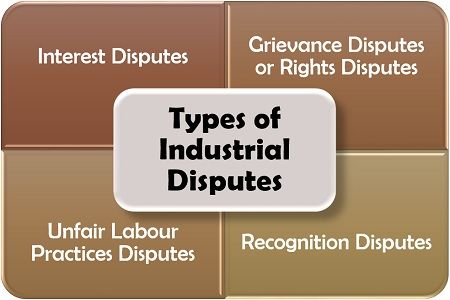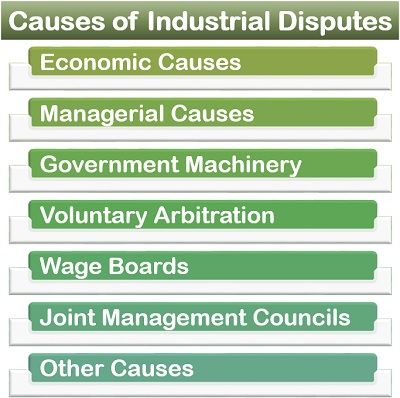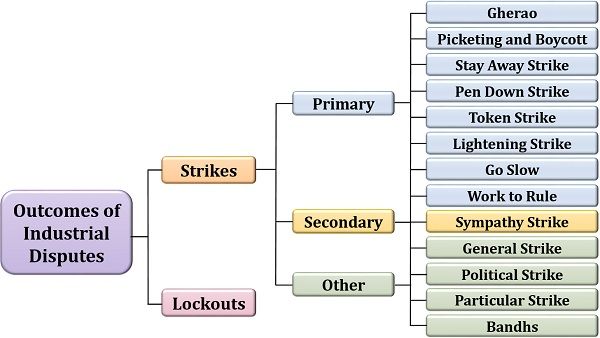Definition: An industrial dispute can be viewed as friction or disagreement between two or more parties involved, due to the difference in their perceptions, opinions, mindsets, attitudes and values. In an organization, the parties engage in such disputes can be:
- Employer and employee;
- employee and employee or;
- employer and employer.
On a massive level, conflicts can even arise between the government and the public.
Industrial disputes are sometimes observed as a result of poor industrial relations in the organization.
Content: Industrial Disputes
Types of Industrial Disputes
How can we categorize the industrial disputes depending upon its purpose?
Based on the objective behind an industrial dispute, we can distinguish it into the following four broad categories:

Interest Disputes
The interest here refers to gains. Therefore, the conflicts concerning the economic or non-economic interests of the employees, such as increasing the remuneration, working conditions, job security and other benefits are called interest disputes.
Recognition Disputes
The trade unions often enter into a dispute with the management during negotiation or collective bargaining for the benefit of its member employees.
Sometimes, for these negotiations, the management denies identifying the trade unions. Even when there are many trade unions in an organization, each one of them struggles to get recognized by the management.
Grievance Disputes or Rights Disputes
The conflicts concerning the employee’s rights and legal issues with the management are termed as grievance disputes. It includes promotions, work duration, leaves allowed, over time, fringe benefits, safety and security.
Unfair Labour Practices Disputes
The disputes over the unethical treatment of the management towards the labour such as discriminating them for holding membership of trade union, restricting communication, employing new workers during strikes and denial to bargain are called unfair labour practices disputes.
Causes of Industrial Disputes
What are the reasons behind industrial disputes?
Even the smallest of the reasons can contribute to the raising of conflicts in an organizational setup if it impacts the respondent to a great extent.
Let us have an in-depth analysis of each of these causes by reaching out to the roots of industrial disputes:

Economic Causes
The ultimate aim of the labour is to earn their livings and meet their economic ends. Whereas, for the business, it is generating profits. Therefore, on the non-fulfilment of these needs, industrial disputes can take place between the management and the labour.
It includes demanding a higher wage, increasing the profits, bonus and allowances, replacing machinery, improving working conditions, duration and other necessary facilities.
Managerial Causes
Lack of administrative support and attention towards labour leads to industrial disputes. Following are the various managerial causes of industrial disputes:
- Retrenchment or layoff of the workers without any reason;
- the inefficiency of the management to initiate leadership in the organization;
- poorly built and dissatisfying recruitment policies and practices;
- the employer does not comply with the agreement and codes such as code of discipline and collective bargaining;
- the management does not acknowledge the trade unions as a representative of the union members, i.e., the workmen.
Government Machinery
At times, the government lacks a suitable strategy to address industrial disputes. Some of the drawbacks of the government machinery which lead to industrial conflicts are as follows:
- The need for growth and development is not considered seriously;
- difficulties in dealing with industrial culture and climate challenges;
- the employers meagrely apply this settlement machinery;
- there is a low level of trust of the employers and the employees, over the government’s settlement machinery.
Voluntary Arbitration
The word arbitration refers to the settlement of any dispute mutually with the help of an arbitrator.
Thus, in voluntary arbitration, there is a third party involved in the settlement process. Its decision can be biased or unacceptable by either of the parties, which can result in further conflicts.
Wage Boards
The Indian government has set up wage boards for determining the suitable wages of the workmen or labourers.
When the workmen are dissatisfied with their remuneration, there arises a condition of an industrial dispute.
Joint Management Councils (JMC)
The government created Joint Management Councils, which consist of equal representatives of both the parties to deal with the worker’s problems, but the idea failed due to lack of efficiency and progress.
Other Causes
The various other causes of industrial disputes are stated below:
- Weak and multiple trade unions result in more conflicts;
- influence of the political party in power, supporting a particular trade union leads to conflicts;
- the adverse effect of the relationship with the central and state governments, unstable political conditions and everyday responsibilities results in industrial disputes;
- in some organizations, collective bargaining is not allowed since the workmen are not even permitted to make trade unions;
- other reasons can be corruption, apparent consumption, role conflicts, etc.
Outcomes of Industrial Disputes
The consequences of an industrial dispute are hazardous to the employer, employees, organization, society and the economy.
However, it is taken as a useful tool by the workers, to raise their voice and put up their demands in front of the management or employers. It empowers the labours and protects their rights of speech in the organization.
Following are some of the essential ways in which the industrial disputes takes shape in the organization and are carried out by the employees as well as the employer sometimes:
Strikes
It is a way through which a group of workmen exercise pressure on the management by stopping the work and protesting against the employers to get their demands fulfilled.
Following are the different types of strikes:
Primary Strikes: The strikes which are directly projected against the employers are called as primary strikes. Some of the most common primary strikes are as follows:
Gherao: Gherao refers to physically encircling the managers by the workmen to create a restricted area where no one can move in or out. The targeted managers are humiliated through; abuses also they are restricted move in or out.
- Picketing: Picketing is the process of putting up signboards, play cards and banners by the workmen to display their protest or dispute in front of the public. To involve maximum workers in the strike, some union members are made to stand at the factory gate to influence others too.
- Boycott: As the name suggests, boycott refers to interrupting business operations. It requests the other labourers to temporarily pull back their co-operation with the management and contribute to the strike.
- Stay Away Strike: In a stay-away strike, the workmen organize a protest in the form of demonstrations, marches, rallies, apart from the workplace.
- Pen Down Strike: It is also known as the sit-down strike or tools down strike. Though the workmen come to the workplace daily and also avails the work facilities, they sit idle and stop working.
- Token Strike: A token strike is a short form of protest where the workmen stop their work for a definite period. It is usually for as short as 24 hours, to hamper a day’s production or so and get their demands fulfilled by the management.
- Lightning Strike: The lightning strike is that form of strikes where the workmen call off the work immediately without giving any prior information or warning to the management. It is also termed as a catcall strike.
- Go Slow Strike: This is another harmful way of protesting against the management where the workmen secretly plan to decrease their work speed so that the production is hampered. However, in front of the management, they pretend to be highly committed towards their job.
- Work to Rule: In this type of strike, the employees strictly follow their job rules or contract and stops performing any additional task, other than what all is mentioned in their agreement.
- Hunger Strike: One of the most common forms of a strike is the hunger strike. The workmen go on fasting for an indefinite period and sit nearby the workplace or the employer’s house to project their demands.
Secondary Strikes: The other name for the secondary strike is the sympathy strike. In this, the force is applied against the third person having sound trade relations with the organization to indirectly incur a loss to the employer and the business. The third person does not have any other role to play in such a strike.
Other Strikes: There are undoubtedly other forms of strike too, which takes place on a vast level involving and affecting a large number of people. These are as follows:
- General Strike: The strikes which are conducted on a mass level, i.e., in the whole country or state or city instead of just a single organization for fulfilment of a demand unanimously like job permanency or an increase in pay, etc.
- Political Strike: Any law or act proposed by the government for making changes to the working terms or conditions when unaccepted by the workers is protested through political strike on a massive level.
- Particular Strike: The protest against a specific issue or person within a city, state or country and take up a colossal form is termed as a particular strike.
- Bandhs: Bandh is adopted in countries like Nepal and India where a specific community or a political party calls for a general strike across the city or state or country. It is a form of civil disobedience and sometimes become violent, even involving stone attacks or arson attacks at times.
Lockouts
This form of an industrial dispute is raised by the employers to impose specific terms and conditions on the workers. It is very different from layoff, retrenchment, termination or prohibition of employees.
In lockouts, the employer temporarily closes down the workplace or stops the work or takes action like suspending the workers to force them to follow the new terms and conditions.

Handel Mac-Williams says
This piece was very useful for my research work
Thanks